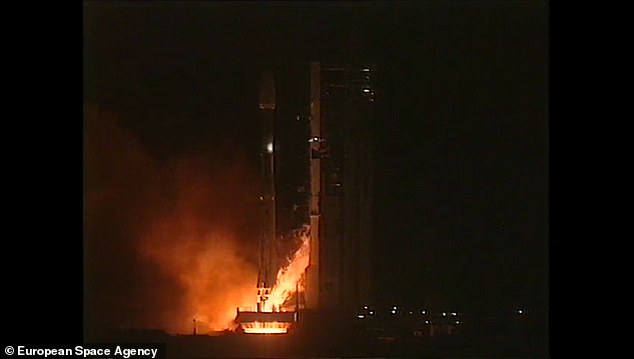It has been floating above our planet for almost 30 years.
But a satellite operated by the European Space Agency (ESA) will finally crash into Earth again this week.
ERS-2, which took off from French Guiana in 1995, weighs just over 5,000 pounds, about the same as an adult rhino.
ESA estimates that it will re-enter Earth’s atmosphere at 11:14 GMT (12:14 CET) on Wednesday (February 21).
Although experts have no idea where it will land, the ESA says the annual risk of a human being injured by space debris is about one in 100 billion.
Artist’s illustration of the European Remote Sensing Satellite 2 (ERS-2) in space. It finally returns to Earth after ending operations more than a decade ago.

Image of ERS-2 captured from space by HEO – an Australian company with an office in the United Kingdom – taken by other satellites between January 14 and February 3. It shows ERS-2 as it rotates on its return journey to Earth. The UK agency says they have been shared with ESA to help track ERS-2 re-entry.
The ESA said there is a level of uncertainty in its 15-hour re-entry prediction.
This means it could re-enter 15 hours either side of 11:14 GMT on Wednesday, although 11:14 GMT is the agency’s best guess.
“This uncertainty is mainly due to the influence of unpredictable solar activity, which affects the density of the Earth’s atmosphere and, therefore, the resistance experienced by the satellite,” he said in a statement.
ESA said it is monitoring the satellite “very closely” alongside international partners and is providing regular updates on a dedicated website.
The ERS-2 satellite was launched on 21 April 1995 from ESA’s Guiana Space Center near Kourou, French Guiana, to study the Earth’s land surfaces, oceans and polar caps.
After 15 years, the space probe was still operational when ESA declared the mission complete in 2011.
After deorbitation maneuvers exhausted the satellite’s remaining fuel, ground control experts began reducing its altitude from approximately 487 miles (785 km) to 356 miles (573 km).
At that time, experts wanted to minimize the risk of collision with other satellites or increasing the cloud of “space debris” that currently surrounds our planet.
Since then, ERS-2 has been in a period of “orbital decay,” meaning it has been getting closer and closer to Earth as it orbits the planet.

ERS-2 satellite before launch. ERS-2 was launched in 1995, following its sister, the first European remote sensing satellite ERS-1, which was launched in 1991. The two satellites were designed as identical twins with one important difference: ERS-2 included an additional instrument to monitor ozone levels in the atmosphere

The ERS-2 satellite was launched in April 1995 from ESA’s Guiana Space Center near Kourou, French Guiana (pictured)
ERS-2 will re-enter Earth’s atmosphere and burn up once its altitude has decreased to about 50 miles (80 km), about one-fifth the distance of the International Space Station.
At this altitude, it will break up into fragments, the vast majority of which will burn up in the atmosphere.
However, some fragments could reach the Earth’s surface, where they “will most likely fall into the ocean,” according to ESA.
“None of these fragments will contain toxic or radioactive substances,” the agency said.
Although it cannot guarantee that there is no chance of ERS-2 hitting someone, ESA did note that the annual risk of a human being, even slightly injured, being caused by space debris is less than one in 100 billion. .
This is approximately 1.5 million times lower than the risk of dying in a domestic accident and 65,000 times lower than the risk of being struck by lightning.
Worryingly, ESA describes the event as a “natural” reentry because ground staff have no way of monitoring it during its descent.
“ERS-2 exhausted the last of its fuel in 2011 to minimize the risk of a catastrophic explosion that could have generated a large amount of space debris,” the agency said.
‘Its batteries were dead and its communication antenna and onboard electronic systems were turned off.

Illustrated timeline of the European Remote Sensing Satellite 2 (ERS-2) mission provided by ESA, which estimates it will re-enter Earth’s atmosphere at 11:14 GMT (12:14 CET) on Wednesday (21 December). February)

This was the last image of ERS-2 captured while it was over Rome, Italy, on July 4, 2011. Shortly after, maneuvers began to deorbit the veteran satellite. Flight operations ended on September 5, 2011.
“There is no longer any possibility to actively control the movement of the satellite from Earth during its descent.”
ERS-2 was launched in 1995, following its sister satellite, ERS-1, which had launched four years earlier.
Both satellites carried the latest high-tech instruments, including a radar altimeter (which sends pulses of radio waves toward the ground) and powerful sensors to measure ocean surface temperature and offshore winds.
ERS-2 had an additional sensor to measure the ozone content in our planet’s atmosphere, which is important for blocking radiation from the sun.
ERS-1 is no longer operational, having suffered a malfunction in 2000, but its exact whereabouts are unknown.



